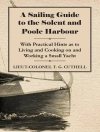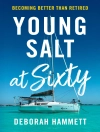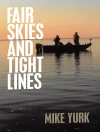This is Part 2 of 2 of The Captain’s Guide to Alternative Energy Afloat.
Part 2 covers the following topics:
• Lighting, Navigation, and Communication
• Refrigeration
• Windvane Self-Steering
• Autopilots
• Manual Windlasses
• Electric Windlasses
• Tools, Spare Parts, and Maintenance Supplies
• The Essence of Green Voyaging.
• Energy Efficiency: Three Cruising Yachts
A successful ocean passage on a small to midsize sailing vessel means keeping things as simple as possible. Sun, Wind, & Water: The Essential Guide to the Energy-Efficient Cruising Boat gives you the most detailed, up-to-date advice on how to prepare your boat for an ocean crossing while at the same time-saving money and ensuring a smaller footprint on Mother Nature.
Circumnavigator-author Bill Morris describes in detail the best options for reducing dependence on fossil fuels, minimizing battery usage, and enjoying a comfortable lifestyle on the water. He presents an array of electrical charging systems, power-saving electrical fixtures, and manual devices aimed at saving money on fuel, along with pointers on installation and maintenance. This practical guide covers:
• The development of an energy-saving plan for your boat
• Battery technology and hydrogen fuel cells
• Charging batteries from sun, wind, and water power
• Battery charge control systems
• Effective refrigeration options for the tropics
• Autopilots and windvane self-steering
• Energy-saving systems on three successful blue water vessels
• And much, much more
Bill Morris, author of The Windvane Self-Steering Handbook and a frequent contributor to Ocean Navigator Magazine, currently cruises the Channel Islands of Southern California on the 1966 Cal 30 Saltaire as he prepares for his next offshore adventure.
Mục lục
Contents
Foreword
Acknowledgements
Introduction
11. Lighting, Navigation, and Communication
Navigation Lights
Cabin Lights
Navigation
Charting
Communications
AC Appliances
12. Refrigeration
Assessing Refrigeration Needs
How Refrigeration Works
Refrigeration and Climate
Air-Cooled Systems
Water-Cooled Systems
Keel-Cooled Refrigeration
Cruiser Options
13. Windvane Self-Steering
Windvane Versus Autopilots
Servopendulums
Trim Tabs
Wind-Powered Auxiliary Rudder
Matching Windvane to Boat
Installation Tips
Emergency Rudder Capability
14. Autopilots
Operating Theory
Above-Deck Systems
Below-Deck Systems
Sailing With an Autopilot
15. Manual Windlasses
Overview of Manual Windlasses
The Simpson-Lawrence Legacy
New Manual Windlasses
16. Electric Windlasses
Overview of Features
Horizontal
Vertical
Drawbacks of Electric Windlasses
Electric Windlass Advantages
17. Tools, Spare Parts, and Maintenance Supplies
Engine and Drive Train
Electrical
Plumbing
Hand Tools
Power Tools
Hull and Deck
Rigging Materials
18. The Essence of Green Voyaging.
Bilge
Marine Sanitation Device
Gray Water
Garbage Overboard
Anchoring and Mooring
Sailing Versus Motoring
Going Ashore
Responsible Fishing
Establishing Personal Standards
19. Energy Efficiency: Three Cruising Yachts
Going the Distance
Contessa 32
Tayana 37
Hallberg-Rassy 46
References
Appendices
Appendix 1: AWG Battery Cable Sizes
Appendix 2: AWG Wire Gauge Sizes
Appendix 3: Beaufort Scale
Appendix 4: Cruiser’s Ham Bands
Appendix 5: Marine Fire Extinguishers
Appendix 6: Sailboat Specifications Decoded
Special Thanks
About the Author
Giới thiệu về tác giả
Circumnavigator-author Bill Morris, a native of Los Angeles, received his first inspiration to sail the world’s oceans at the age of twelve when his father offhandedly suggested selling the house and circling the globe aboard a large yacht.
Though the proposal was soon abandoned, the idea was permanently engraved in Bill’s imagination. Serving as a radio repairman and later as an outboard motor mechanic in the U.S. Army while stationed in the Panama Canal Zone during the mid-1970s, he picked up valuable skills that would help him later in life as a cruising sailor.
He went on to receive a Ph.D. in Administrative and Policy Studies in Education from UCLA, amassing nearly 30 years’ experience in teaching writing at the secondary and college levels in Southern California, South Florida, and American Samoa. Bill and his wife Marilu eventually crossed the Pacific from Panama to Mooloolaba Harbour, Queensland, Australia, and then to Darwin, Northern Territory, aboard their 1966 Cal 30 Saltaire.
After Marilu left Saltaire to give birth to their daughter, Yasmin, Bill continued west back to Los Angeles by way of the two canals, surviving a Somali pirate attack in the Gulf of Aden. Bill is the author of The Windvane Self-Steering Handbook (International Marine, 2004), and he has written many articles on both cruising adventure and alternative energy for offshore vessels in Afloat, Blue Water Sailing, Latitude 38, Ocean Navigator, and Ocean Voyager magazines.












